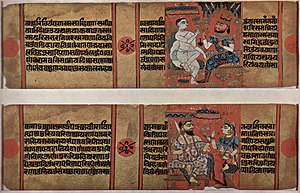Vikram Samvat
This article does not have any sources. (June 2024) |
The Vikram era, or Vikram samvat is a calendar system (mostly followed in Hinduism and Sikhism from people of Indian Subcontinent, while people from Nepal follows it as their main calendar) starting in 57 BC. The Vikram Samvat calendar starts half a century before the Gregorian calendar and works on an Indian calendar cycle.
The calendar starts in the month of Vaishak, which usually falls in the Gregorian month of February/March and ends in Chaitra which falls in March and April.
The date marks the day when the King Vikramāditya beat the Sakas, who had invaded Ujjain. A new calendar was started to honor this achievement.

The story
changeThe story of this event is told by a sadhu (Jain monk) called Mahesara Suri.
The powerful king of Ujjain, called Gardabhilla, kidnapped a sadhvi (Jain nun), who was the sister of the sadhu. The sadhu went to the Saka King to get help, and in the end, the Saka King beat Gardabhilla and captured him and made him a prisoner. But in the end, Gardabhilla was forgiven and run away to a forest, where he was killed by a tiger.
Later on Vikramaditya invaded Ujjain and drove away the Sakas. To commemorate this event he started a new era called the Vikrama era.